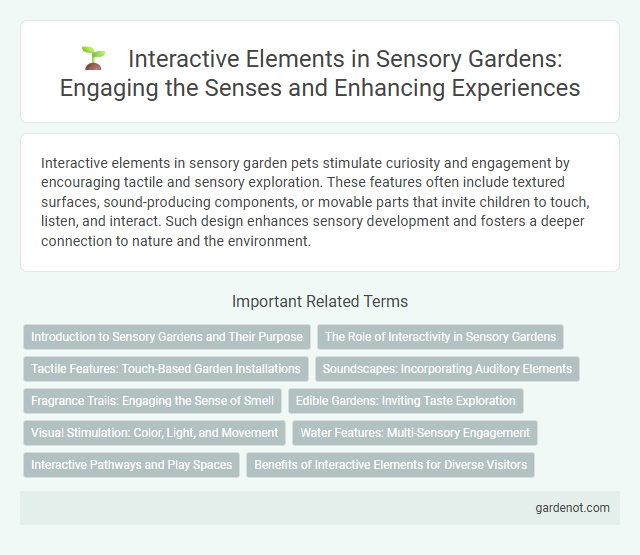Interactive elements in sensory garden pets stimulate curiosity and engagement by encouraging tactile and sensory exploration. These features often include textured surfaces, sound-producing components, or movable parts that invite children to touch, listen, and interact. Such design enhances sensory development and fosters a deeper connection to nature and the environment.
Introduction to Sensory Gardens and Their Purpose
Sensory gardens are designed to engage all five senses through interactive elements such as textured plants, aromatic herbs, tactile sculptures, and sound features like wind chimes or water fountains. These gardens promote mental well-being, stimulate cognitive function, and enhance sensory development, especially beneficial for children, seniors, and individuals with sensory processing disorders. Incorporating diverse sensory stimuli helps create an immersive environment that fosters relaxation, learning, and therapeutic experiences.
The Role of Interactivity in Sensory Gardens
Interactive elements in sensory gardens are essential for engaging multiple senses, fostering exploration and enhancing cognitive development. Features such as tactile paths, sound installations, and aromatic plants stimulate touch, hearing, and smell, creating immersive experiences that promote sensory integration. These interactive components also support therapeutic outcomes by encouraging active participation and mindfulness in natural settings.
Tactile Features: Touch-Based Garden Installations
Tactile features in sensory gardens include touch-based installations such as textured pathways, interactive sculptures, and plant varieties with diverse leaf surfaces that invite exploration through touch. These elements enhance sensory engagement by stimulating nerve endings and promoting fine motor skills development. Incorporating materials like smooth stones, rough bark, and soft moss creates varied tactile experiences essential for therapeutic and educational garden designs.
Soundscapes: Incorporating Auditory Elements
Soundscapes in sensory gardens integrate natural and designed auditory elements such as wind chimes, water features, and bird calls, enriching visitors' sensory experience. These auditory elements promote relaxation, enhance cognitive engagement, and support sensory processing for individuals with diverse needs. Carefully curated soundscapes stimulate auditory pathways while complementing visual and tactile garden components, creating an immersive multisensory environment.
Fragrance Trails: Engaging the Sense of Smell
Fragrance trails in sensory gardens enhance the sense of smell by guiding visitors through pathways rich with aromatic plants such as lavender, rosemary, and jasmine. These interactive elements stimulate memory and emotional responses by immersing individuals in diverse scents that change with the seasons. Incorporating natural fragrances supports therapeutic benefits, improving mood and cognitive function while creating a multi-sensory experience.
Edible Gardens: Inviting Taste Exploration
Edible gardens in sensory spaces engage visitors through interactive elements that stimulate taste and smell, fostering a multisensory experience. Incorporating herbs, fruits, and vegetables invites hands-on exploration, encouraging individuals to touch, smell, and sample fresh plants. This tactile and gustatory interaction enhances learning and connection to nature while promoting healthy eating habits.
Visual Stimulation: Color, Light, and Movement
Interactive elements in a sensory garden enhance visual stimulation through vibrant colors, dynamic lighting, and motion-based features. Incorporating elements like color-changing LED installations, kinetic sculptures, and reflective surfaces maximizes engagement and sensory exploration. These visual stimuli promote cognitive development and sensory integration for all ages, particularly benefiting individuals with sensory processing disorders.
Water Features: Multi-Sensory Engagement
Water features in sensory gardens offer dynamic multi-sensory engagement by combining visual movement, soothing sounds, and tactile interaction. Flowing streams, gentle fountains, or bubbling pools stimulate auditory senses while encouraging touch and exploration, enhancing cognitive and emotional connection to nature. Incorporating water elements increases visitor immersion and therapeutic benefits by engaging multiple sensory pathways simultaneously.
Interactive Pathways and Play Spaces
Interactive pathways in sensory gardens engage visitors by incorporating varied textures, sounds, and visual stimuli, enhancing multi-sensory exploration. Play spaces within these gardens feature tactile installations, water elements, and aromatic plants designed to stimulate curiosity and encourage hands-on interaction. These elements foster inclusive experiences, promoting physical activity and cognitive development for all age groups.
Benefits of Interactive Elements for Diverse Visitors
Interactive elements in sensory gardens enhance visitor engagement by stimulating multiple senses, improving accessibility for individuals with varied abilities. These features foster cognitive development, emotional well-being, and social interaction, making the garden inclusive for children, elderly, and those with sensory processing disorders. Incorporating tactile, auditory, and olfactory components supports diverse learning styles and promotes therapeutic benefits for all visitors.
Interactive element Infographic

 gardenot.com
gardenot.com